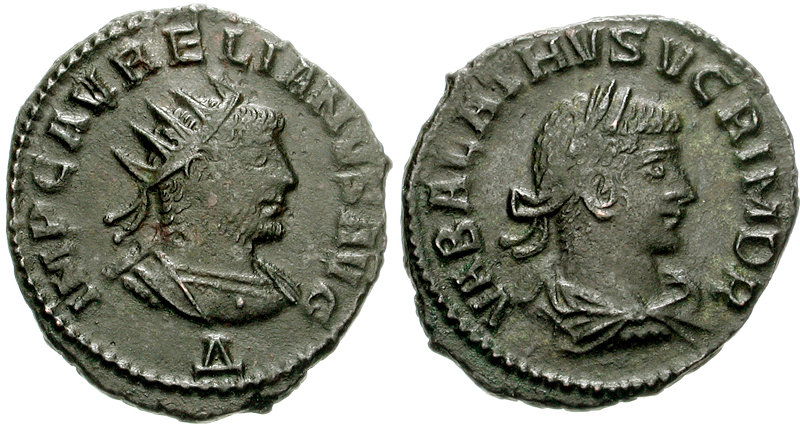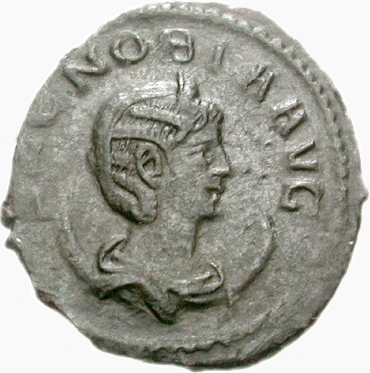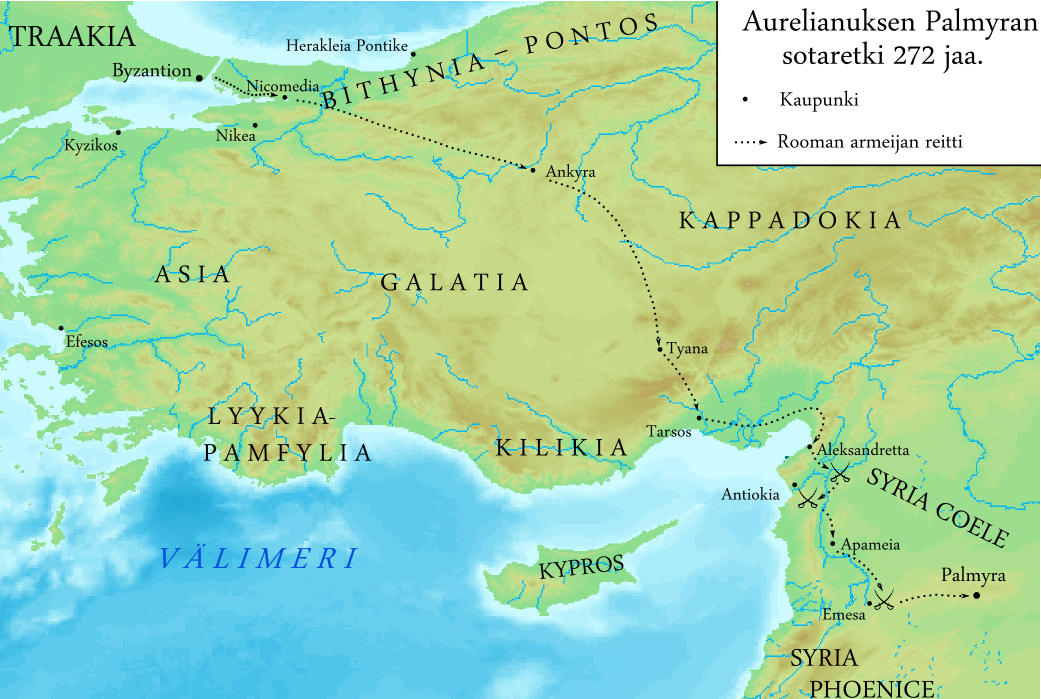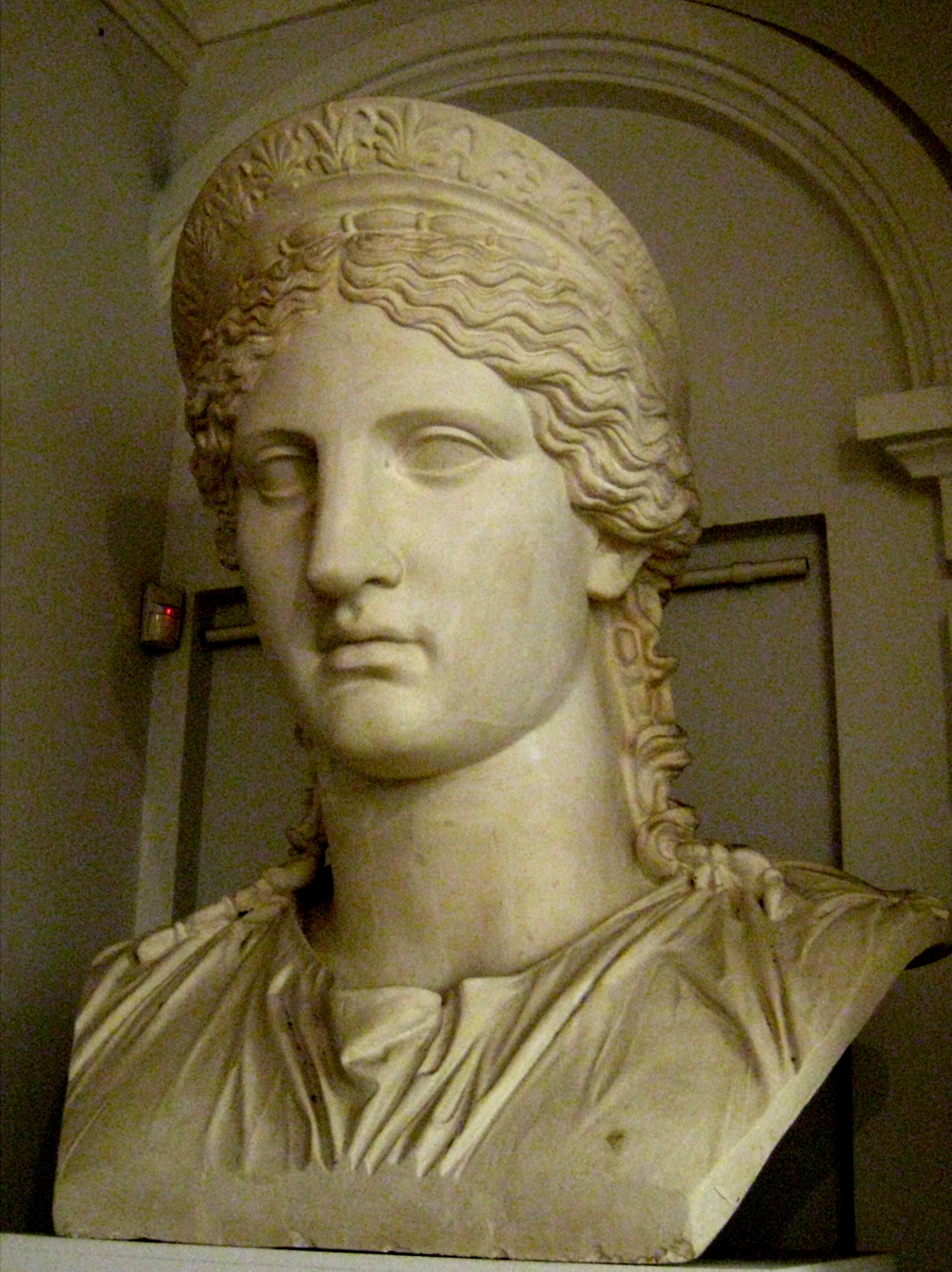|
Zenobia
Septimia Zenobia (Greek: Ζηνοβία, Palmyrene Aramaic: , ; 240 – c. 274) was a third-century queen of the Palmyrene Empire in Syria. Many legends surround her ancestry; she was probably not a commoner, and she married the ruler of the city, Odaenathus. Her husband became king in 260, elevating Palmyra to supreme power in the Near East by defeating the Sasanian Empire of Persia and stabilizing the Roman East. After Odaenathus' assassination, Zenobia became the regent of her son Vaballathus and held de facto power throughout his reign. In 270, Zenobia launched an invasion that brought most of the Roman East under her sway and culminated with the annexation of Egypt. By mid-271 her realm extended from Ancyra, central Anatolia, to Upper Egypt, although she remained nominally subordinate to Rome. However, in reaction to the campaign of the Roman emperor Aurelian in 272, Zenobia declared her son emperor and assumed the title of empress, thus declaring Palmyra's secession f ... [...More Info...] [...Related Items...] OR: [Wikipedia] [Google] [Baidu] |
Palmyrene Empire
The Palmyrene Empire was a short-lived breakaway state from the Roman Empire resulting from the Crisis of the Third Century. Named after its capital city, Palmyra, it encompassed the Roman provinces of Syria Palaestina, Arabia Petraea, and Egypt (Roman province), Egypt, as well as large parts of Anatolia, Asia Minor. The Palmyrene Empire was ruled by Queen Zenobia, officially as regent for her son Vaballathus, who inherited the throne in 267 at age ten. In 270, Zenobia rapidly conquered most of the Roman east, attempting to maintain relations with Rome as a legitimate power. In 271, she claimed the imperial title for both herself and her son, fighting a short war with the Roman emperor Aurelian, who conquered Palmyra and captured Zenobia. A year later the Palmyrenes rebelled, which led Aurelian to raze Palmyra. Despite its brief existence, the Palmyrene Empire is remembered for having been ruled by one of the most ambitious and powerful women in antiquity. It is also hailed in mo ... [...More Info...] [...Related Items...] OR: [Wikipedia] [Google] [Baidu] |
Palmyra
Palmyra ( ; Palmyrene dialect, Palmyrene: (), romanized: ''Tadmor''; ) is an ancient city in central Syria. It is located in the eastern part of the Levant, and archaeological finds date back to the Neolithic period, and documents first mention the city in the early second millennium BCE. Palmyra changed hands on a number of occasions between different empires before becoming a subject of the Roman Empire in the first century CE. The city grew wealthy from caravan (travellers), trade caravans; the Palmyrenes became renowned as merchants who established colonies along the Silk Road and operated throughout the Roman Empire. Palmyra's wealth enabled the construction of monumental projects, such as the Great Colonnade at Palmyra, Great Colonnade, the Temple of Bel, and the distinctive tower tombs. Ethnically, the Palmyrenes combined elements of Amorites, Arameans, and Arabs. Socially structured around kinship and clans, Palmyra's inhabitants spoke Palmyrene Aramaic, a variety of A ... [...More Info...] [...Related Items...] OR: [Wikipedia] [Google] [Baidu] |
Odaenathus
Septimius Odaenathus (Greek language, Greek: Ὀδαίναθος, Palmyrene Aramaic: 𐡠𐡣𐡩𐡮𐡶 (file:Dynt.png, 35px), ; ; 220 – 267) was the founder king (malik) of the List of Palmyrene monarchs, Palmyrene Kingdom who ruled from Palmyra, Syria. He elevated the status of his kingdom from a regional center subordinate to Rome into a formidable state in South-West Asia. Odaenathus was born into an aristocratic Palmyrene family that had received Roman citizenship in the 190s under the Severan dynasty. He was the son of Hairan, the descendant of Nasor. The circumstances surrounding his rise are ambiguous; he became the lord (''ras'') of the city, a position created for him, as early as the 240s and by 258, he was styled a ''consularis'', indicating a high status in the Roman Empire. The defeat and captivity of Valerian (emperor), Emperor Valerian at the hands of the Sasanian Empire, Sasanian emperor Shapur I in 260 left the eastern Roman provinces largely at the mer ... [...More Info...] [...Related Items...] OR: [Wikipedia] [Google] [Baidu] |
Vaballathus
Septimius Vaballathus (Palmyrene Aramaic: ; "Gift of Allāt"; 259 – c. 274 AD) was emperor of the Palmyrene Empire centred at Palmyra in the region of Syria. He came to power as a child under his regent mother Zenobia, who led a revolt against the Roman Empire and formed the independent Palmyrene Empire. Early life Lucius Julius Aurelius Septimius Vaballathus was born and raised in the city of Palmyra, an oasis settlement in the Syrian Desert in 259 to the king of kings of Palmyra, Odaenathus, and his second wife, the queen consort of Palmyra, Zenobia. Vaballathus is the Latinized form of his Palmyrene name, ''Wahballāt'', "Gift of Allāt". As the Arabian goddess Allāt came to be identified with Athena, he used ''Athenodorus'' as the Greek form of his name. He had a half-brother, Hairan I, born from his father and another woman, who reigned as co-king of kings with his father, and a lesser-known brother, Hairan II. He also might have had other brothers, who were men ... [...More Info...] [...Related Items...] OR: [Wikipedia] [Google] [Baidu] |
Palmyrene Invasion Of Egypt
The Palmyrene invasion of Egypt occurred in the summer, or possibly in October, of 270 AD when the forces of Queen Zenobia of Palmyra, led by her general Zabdas and aided by an Egyptian general named Timagenes, invaded and subsequently annexed Egypt, which was under control of the Roman Empire at the time. The invasion of Egypt is sometimes explained by Zenobia's desire to secure an alternative trade route to the Euphrates, which was cut because of the war with the Sasanian Empire, although the Euphrates route was only partially disrupted. Zenobia's personal ambition and political motivation to establish Palmyrene dominance over the east definitely played a part in her decision to invade Egypt. The invasion coincided with, or probably even caused, serious unrest in Egypt, whose people were split between supporting and defying the approaching Palmyrene army. What also made the situation worse for the Romans was that the prefect of Egypt, Tenagino Probus, was at the time preoccu ... [...More Info...] [...Related Items...] OR: [Wikipedia] [Google] [Baidu] |
Aurelian
Aurelian (; ; 9 September ) was a Roman emperor who reigned from 270 to 275 AD during the Crisis of the Third Century. As emperor, he won an unprecedented series of military victories which reunited the Roman Empire after it had nearly disintegrated under the pressure of barbarian invasions and internal revolts. Born in modest circumstances, most likely in Moesia, Moesia Superior, he entered the Roman army in 235 and climbed up the ranks. He went on to lead the cavalry of the emperor Gallienus, until Gallienus' Gallienus#Assassination, assassination in 268. Following that, Claudius Gothicus became emperor until his own death in 270. Claudius' brother Quintillus then ruled for three months, before Aurelian took the empire for himself. Aurelian was chosen Roman emperor by the Illyrians, Illyriciani as one of themselves. During his reign, he defeated the Alamanni after a devastating war. He also defeated the Goths, Vandals, Juthungi, Sarmatians, and Carpi (people), Carpi. Aurelian ... [...More Info...] [...Related Items...] OR: [Wikipedia] [Google] [Baidu] |
Hairan II
Hairan II was a Palmyrene prince, the son of king Odaenathus and, possibly, his second wife Zenobia. Seal RTP 736 The existence of Hairan was established by the discovery of a lead seal (code named RTP 736). The seal bears the images of two priests, one on each side. On one of the sides, the name of Odaenathus' son and successor Vaballathus Septimius Vaballathus (Palmyrene Aramaic: ; "Gift of Allāt"; 259 – c. 274 AD) was emperor of the Palmyrene Empire centred at Palmyra in the region of Syria. He came to power as a child under his regent mother Zenobia, who led a revolt ag ... was engraved under the image as a legend, while the name of Hairan was engraved on the other side. The name of Odaenathus was engraved on both sides. No name of a mother was engraved and the seal is undated. King Herodianus and Hairan II Odaenathus had another son, Hairan I, who appeared in different inscriptions dated from 251 AD onward. On a lead seal, the name of Septimius Herodianus, k ... [...More Info...] [...Related Items...] OR: [Wikipedia] [Google] [Baidu] |
List Of Palmyrene Monarchs
Below is a list of Palmyrene monarchs, the monarchs that ruled and presided over the city of Palmyra and the subsequent Palmyrene Empire in the 3rd century AD, and the later vassal princes of the Al Fadl dynasty which ruled over the city in the 14th century. House of Odaenathus Odaenathus, the lord of Palmyra, declared himself king before riding into battle against the Sassanid Empire, Sassanians after news of the Roman Empire, Roman defeat at Battle of Edessa, Edessa reached him. This elevated Palmyra from a subordinate city to a de facto independent kingdom allied to Rome. Odaenathus later elevated himself to the title of King of Kings, crowning his son co-King of Kings in 263. The title was later passed to Vaballathus his son, before it was dropped for the title of King and later Emperor. Al Fadl dynasty References {{Reflist, 3 Palmyrene monarchs, * Lists of monarchs, Palmyrene ... [...More Info...] [...Related Items...] OR: [Wikipedia] [Google] [Baidu] |
Septimius Antiochus
Septimius Antiochus (Greek: Άντίοχος; died after 273) was a Roman usurper in Syria during the 3rd century. In 272 AD, Emperor Aurelian had defeated the breakaway Kingdom of Palmyra; its king, Vaballathus, and his mother, Zenobia, were in Roman captivity. In 273 AD, another rebellion against Roman rule broke out in Palmyra. The rebels first approached Aurelian's governor, Marcellinus, about becoming emperor, but he pretended to consider the offer while sending a letter to Aurelian warning of the rebellion. While the rebels waited, they decided to elevate Septimius Antiochus, the reputed son of Zenobia, to the purple. When the emperor received Marcellinus' letter, he acted quickly, and the city was restored to Roman rule in the spring of 273. Aurelian punished the city severely, but is said to have spared Antiochus. Antiochus claimed to be descended from Queen Cleopatra VII Cleopatra VII Thea Philopator (; The name Cleopatra is pronounced , or sometimes in bot ... [...More Info...] [...Related Items...] OR: [Wikipedia] [Google] [Baidu] |
Roman Egypt
Roman Egypt was an imperial province of the Roman Empire from 30 BC to AD 642. The province encompassed most of modern-day Egypt except for the Sinai. It was bordered by the provinces of Crete and Cyrenaica to the west and Judaea, later Arabia Petraea, to the East. Egypt was conquered by Roman forces in 30 BC and became a province of the new Roman Empire upon its formation in 27 BC. Egypt came to serve as a major producer of grain for the empire and had a highly developed urban economy. It was by far the wealthiest Roman province outside of Italy. The population of Roman Egypt is unknown, although estimates vary from . Alexandria, its capital, was the largest port and second largest city of the Roman Empire. Three Roman legions garrisoned Egypt in the early Roman imperial period, with the garrison later reduced to two, alongside formations of the Roman army. The major town of each '' nome'' (administrative region) was known as a metropolis and gr ... [...More Info...] [...Related Items...] OR: [Wikipedia] [Google] [Baidu] |
List Of Augustae
(; plural ; ) was a Roman Empire, Roman imperial honorific title given to List of Roman and Byzantine empresses, empresses and women of the imperial families. It was the Feminine gender, feminine form of ''Augustus (title), Augustus''. In the third century, could also receive the titles of ("Mother of the Senate"), ("Mother of the Camp"), and ("Mother of the Fatherland"). could issue their own coinage, wear imperial regalia, and rule their own Royal court, courts. Agrippina the Younger, Agrippina, the wife of Claudius, was the first living wife of the emperor in Roman history to receive the title of , a position she held for the rest of her life, ruling with her husband and son. In the third century, Julia Domna was the first empress to receive the combined title after the death of her husband Septimius Severus, which may have implied greater powers being vested in her than was usual for a Roman empress mother. In this official position and honor, she accompanied her s ... [...More Info...] [...Related Items...] OR: [Wikipedia] [Google] [Baidu] |
Ancyra
Ankara is the capital city of Turkey and the largest capital by area in the world. Located in the central part of Anatolia, the city has a population of 5,290,822 in its urban center ( Etimesgut, Yenimahalle, Çankaya, Keçiören, Altındağ, Pursaklar, Mamak, Gölbaşı, Sincan) and 5,864,049 in Ankara Province (total of 25 districts). Ankara is Turkey's second-largest city by population after Istanbul, first by urban land area, and third by metro land area after Konya and Sivas. Ankara was historically known as Ancyra and Angora. Serving as the capital of the ancient Celtic state of Galatia (280–64 BC), and later of the Roman province with the same name (25 BC–7th century), Ankara has various Hattian, Hittite, Lydian, Phrygian, Galatian, Greek, Persian, Roman, Byzantine, and Ottoman archeological sites. The Ottomans made the city the capital first of the Anatolia Eyalet (1393 – late 15th century) and then the Angora Eyalet (1827–1864) a ... [...More Info...] [...Related Items...] OR: [Wikipedia] [Google] [Baidu] |










